Have you noticed large numbers of Canada Geese at Vilas Park lately? What about Tenney Park, Cherokee Park or Yahara Hills Golf Course? The overabundance of these waterfowl is a common complaint received by park users and a problem left for many municipalities to resolve. A problem ultimately created in part by a developed urban landscape.
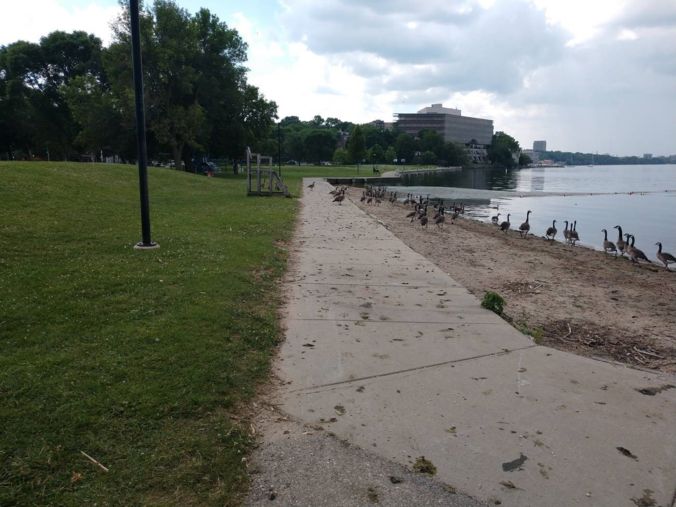
Ten years ago, an advisory group was formed to study impacts from increasingly abundant waterfowl and gull populations at Vilas Park, and develop recommendations for habitat and population management. A year of research compiled information from the previous decade on several issues:
- Disease risks including beach closures due to elevated bacteria levels
- Landscape damage including soil compaction and erosion and decline or removal of vegetation
- Safety concerns including geese and droppings on roadways and bike paths
The Vilas Park Waterfowl Management Plan provided an array of management options and was reviewed by the Board of Park Commissioners (BPC). Parks staff was directed to investigate the issue system-wide and provide options and plans for Canada Goose management on parklands. The BPC ultimately authorized staff to use all appropriate tools as needed to keep the goose population "under control to maintain public health and water quality." (BPC Meeting Minutes, May 11, 2011)
Since then, Madison Parks has used an integrated management approach to limit the number of Canada Geese throughout the park system. The goals of this program are to improve and maintain water quality, protect public health, maintain safe traffic flow on bike paths, and improve the visitor experience. Staff and volunteers monitor the number of geese present at certain sites from early spring through fall. Target population sizes are determined for each site based on park size and layout, goose habits, and observed impacts such as beach closures and the amount of waste produced. A combination of practices is used to regulate the numbers of geese present.
The objective is not to eliminate the geese but rather to keep the population at a level that is sustainable for the landscape and for public health and safety.
Current goose management practices include:
- Signage and enforcement – Feeding geese or any species of bird on City property is prohibited by Madison General Ordinance 8.42. Signs are posted in parks and at beaches throughout the city to inform the public, and citations are issued for violations.
- Habitat modification – Buffer strips of tall vegetation have been established in parks on the edges of water bodies, and remain un-mowed all summer. This discourages geese from using these areas because the tall vegetation restricts their access to the water.
- Fencing – Fences are installed on beaches each spring to deter geese from roosting there and from using the beach as an access point to the park.
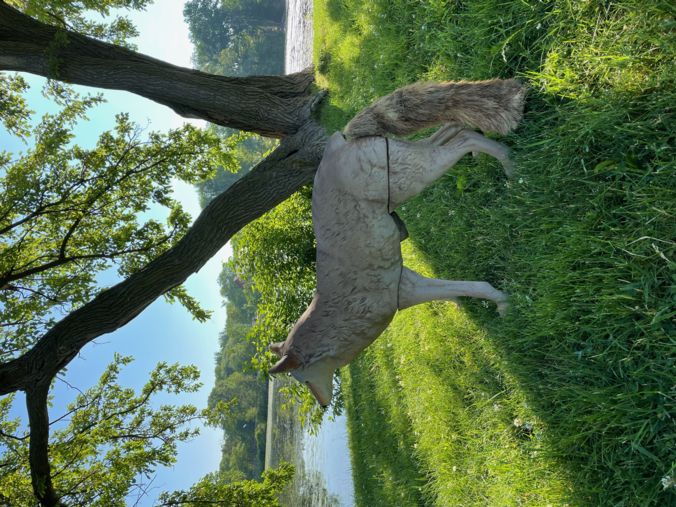
Photo Courtesy: S. Mayer
- Lighting – Amber strobe lights are placed on beaches and other areas to deter geese from roosting overnight during the summer. The lights disturb their sleep, and they leave to find more suitable roosting locations.
- Predator decoys – Three-dimensional coyote decoys are used in conjunction with hazing at some sites. Likelike and not-so-lifelike models are placed at heavily used sites and moved daily to prevent geese from becoming habituated.
- Repellants – Liquid repellant (based on artificial grape food flavoring) is applied on a limited basis to some turf areas to discourage geese from grazing there. The repellant irritates their nasal passages and esophagus when they graze on grass that has been treated. Much like hot pepper-based repellants used in gardens.
- Egg oiling – Under a permit from the Wisconsin DNR, staff and volunteers search for Canada Goose nests each spring on City property and apply corn oil to eggs to prevent them from developing and hatching.
- Hazing – A maximum desired number of geese is determined for each park on a site-by-site basis to minimize negative impacts. Staff and volunteers monitor and record goose numbers, and scare away the geese if more than the desired number are present. This is done all spring and summer, except while the geese are molting and cannot fly – usually in late June. This prevents undue stress on the geese. Efforts are focused on beaches, athletic fields, and high-use areas.
- Lethal take – Staff evaluate local goose population sizes each year on a park-by-park basis, and determine whether a harvest is necessary. When all other efforts are exhausted, the City works with the U.S. Department of Agriculture Animal and Plant Health Inspection Service (USDA APHIS), Wildlife Services under state and federal permits to capture live geese. The geese are then transported to a meat processing facility, where they are euthanized and processed into food. The meat is donated to food pantries.
Not one of these practices can be successful without the others. Much like the ecological management of our conservation parks, greenways, and other natural areas, wildlife management in our developed recreation areas – which are part of the wider ecosystem – requires a broader view and awareness of the context in which it occurs.
While we can make parks and beaches less inviting to geese, and "train" the ones that do show up to avoid certain parks or portions of parks, we still need to consider the local resident goose population. This is why we oil eggs on all City property (parks and stormwater greenways) to help reduce the total population. Breeding pairs that do produce a brood, from nests located on non-City property or nests not found and oiled, often bring their young downstream and across lakes to large turf areas for easy grazing. Large turf areas like waterfront parks and golf courses. With far fewer predators than natural areas, these parks quickly become overcrowded with geese, each producing 1 pound or more of waste each day.
Goslings mature in one year and start breeding the next spring after they hatch. Each female goose can lay up to 11 eggs in a single clutch. We found an average clutch size of 5 eggs this year. This means the population can grow exponentially. Using some over-simplified math to illustrate. The first year, let's say we have 100 geese (50 males + 50 female) who produce 250 goslings (50 female geese lay 5 eggs each) this equals 350 geese by fall. Even if half of the geese don't survive or move to another city, this still leaves 175 geese to repeat the process. Below is a graph illustrating this process over a 6-year span.
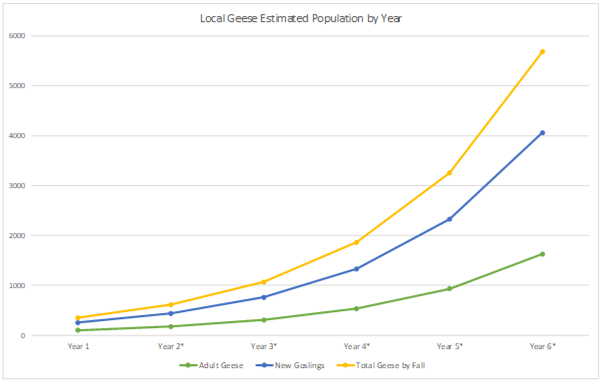
*assuming only 50% of the geese return each year due to survival rates and/or moving to another city/state
We put significant effort into oiling eggs, and monitoring and hazing geese. Often these methods are sufficient for meeting our goals, but a lethal take is still a necessary option when warranted. Data from the past ten years shows a reduced reliance on the lethal take, as we have continued to increase egg oiling efforts and expand the use of deterrents such as shoreline buffer strips, fencing, lights, and hazing.
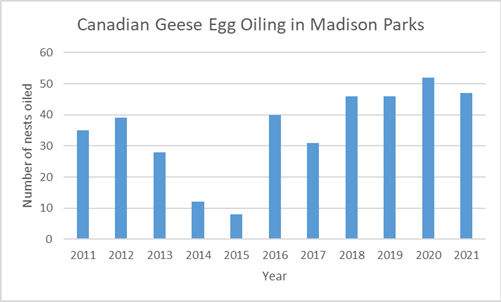
Our goal with hazing is to discourage large flocks from forming and staying at any given park. We try to create an unsettling environment so geese associate that site as an unsafe place. Hazing is most successful when it is repeated daily until a group disperses. Sometimes the whole flock leaves, and sometimes the numbers are reduced to acceptable levels. USDA - Animal and Plant Health Inspection Service (APHIS) found that Canada Goose numbers were reduced by 85% after 5 days at sites where they were hazed for a 30-minute period each evening. And it works! We regularly have success at Vilas, Tenney, and Law parks.
How can you help?
To haze geese, simply walk toward them and make some noise. You can clap your hands and whistle, wave your arms, open and close an umbrella, or all of the above. The geese will move away from you, and you might have to move back and forth to herd them into the water. Young goslings can swim away and the family group will find a new place to graze and roost. Adults stay with the young at least until they can fly. When they can fly, it seems to take a little more effort to scare them off. Hazing early in the morning or in the evening as geese settle to roost is especially effective. Never touch the geese or throw anything at them when hazing them. (That's illegal!) We also use a hand-held laser (aimed at the ground near the geese) and a radio-controlled boat to scare them away.
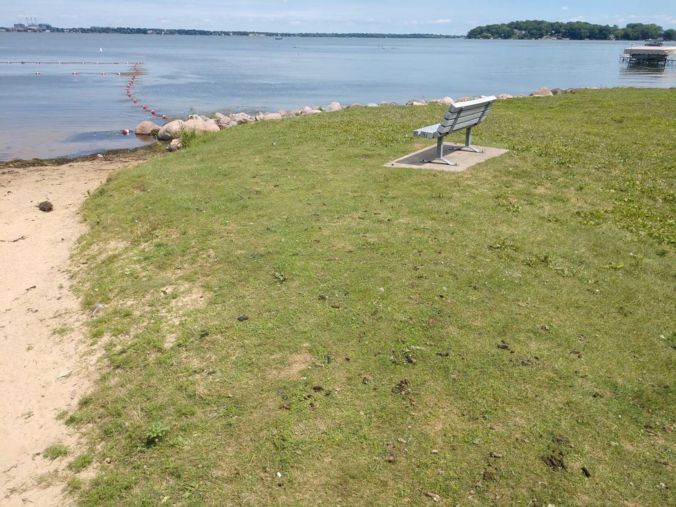
So when you are out enjoying your parklands this summer, take notice of the shorelines. Look for erosion, excessive algae in the water, and excessive goose waste on the grass or beach. We are always interested in your feedback and hearing all public perspectives.
Email Your Observations and Feedback: parks@cityofmadison.com
This content is free for use with credit to Madison Parks and a link back to the original post.
